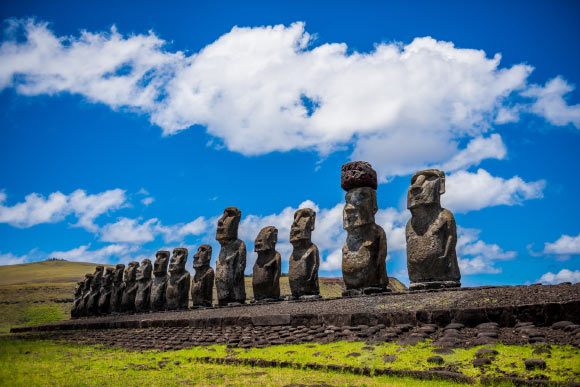New research provides evidence contrary to the widely-held belief that the prehistoric population of Easter Island (Rapa Nui) caused an ecological disaster through rapid deforestation and over-exploitation of natural resources.

Easter Island, known as Rapa Nui to its earliest inhabitants, is one of the most remote inhabited islands in the world. Image credit: Yerson Retamal.
The new findings, published in the American Journal of Physical Anthropology, support the idea that the story of Easter Island is more interesting and complex than assumed.
“The traditional story is that over time the people of Rapa Nui used up their resources and started to run out of food,” said co-author Carl Lipo, professor of anthropology at Binghamton University.
“One of the resources that they supposedly used up was trees that were growing on the island. Those trees provided canoes and, as a result of the lack of canoes, they could no longer fish.”
“So they started to rely more and more on land food. As they relied on land food, productivity went down because of soil erosion, which led to crop failures.”
“Painting the picture of this sort of catastrophe. That’s the traditional narrative,” he said.
Professor Lipo and his colleagues from the University of Bristol in the UK, the Christian-Albrechts-Universität in Germany, Kon-Tiki Museum in Norway, and the Universities of Oregon and Hawai’i, analyzed human, faunal and botanical remains from the archaeological sites Anakena and Ahu Tepeu on Easter Island, dating from 1400 CE to the historic period.
The researchers used bulk carbon and nitrogen isotope analyses and amino acid compound specific isotope analyses of collagen isolated from prehistoric human and faunal bone, to assess the use of marine versus terrestrial resources and to investigate the underlying baseline values.
Similar isotope analyses of archaeological and modern botanical and marine samples were used to characterize the local environment.
The results of carbon and nitrogen analyses independently show that around half the protein in diets from the humans measured came from marine sources; markedly higher than previous estimates.
“We found that there’s a fairly significant marine diet, over time, throughout history and that people were eating marine resources, and it wasn’t as though they only had food from terrestrial resources,” Professor Lipo said.
“We also learned that what they did get from terrestrial resources came from very modified soils, that they were enriching the soils in order to grow the crops.”

Rapanui people. Image credit: © Santiago Caruso.
The findings point to concerted efforts to manipulate agricultural soils, and suggest the prehistoric Easter Islanders had extensive knowledge of how to overcome poor soil fertility, improve environmental conditions, and create a sustainable food supply.
These activities demonstrate considerable adaptation and resilience to environmental challenges — a finding that is inconsistent with an ‘ecocide’ narrative.
“The Rapa Nui people were, not surprisingly, smart about how they used their resources,” Professor Lipo said.
“And all the misunderstanding comes from our preconceptions about what subsistence should look like, basically European farmers thinking, ‘Well, what should a farm look like?’ And it didn’t look like what they thought, so they assumed something bad had happened, when in fact it was a perfectly smart thing to do.”
“It continues to support the new narrative that we’ve been finding for the past ten years.”
_____
Catrine L. Jarman et al. Diet of the prehistoric population of Rapa Nui (Easter Island, Chile) shows environmental adaptation and resilience. American Journal of Physical Anthropology, published online June 30, 2017; doi: 10.1002/ajpa.23273







